
What if conventional wisdom regarding our most fundamental energy requirements has been wrong all along and we can directly harness the energy of the Sun when we consume ‘plant blood’?
Plants are amazing, aren’t they? They have no need to roam about hunting other creatures for food, because they figured out a way to capture the energy of the Sun directly through these little light-harvesting molecules known as chlorophyll; a molecule, incidentally, which bears uncanny resemblance to human blood because it is structurally identical to hemoglobin, other than it has a magnesium atom at its core and not iron as in red blooded animals.
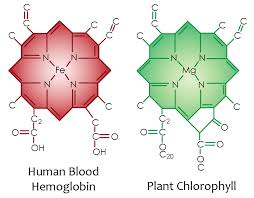
The energy autonomy of plants makes them, of course, relatively peaceful and low maintenance when compared to animal life, the latter of which is always busying itself with acquiring its next meal, sometimes through violent and sometimes through more passive means. In fact, so different are these two classes of creatures that the first, plants, are known as autotrophs, i.e. they produce their own food, and the animals are heterotrophs, i.e. they depend on other creatures for food.

While generally these two zoological classifications are considered non-overlapping, important exceptions have been acknowledged. For instance, photoheterotrophs — a sort of hybrid between the autotroph and heterotroph — can use light for energy, but cannot use carbon dioxide like plants do as their sole carbon source, i.e. they have to ‘eat’ other things. Some classical examples of photoheterotrophs include green and purple non-sulfur bacteria, heliobacteria, and here’s where it gets interesting, a special kind of aphid that borrowed genes from fungi[1] to produce it’s own plant-like carotenoids which it uses to harness light energy to supplement its energy needs!
To learn more about this amazing creature read the study published in 2012 in Scientific Reports titled, “Light- induced electron transfer and ATP synthesis in a carotene synthesizing insect.”
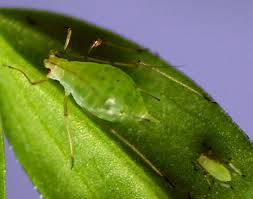
A green carotenoid tinted aphid that is capable of capturing sunlight to produce energy. Interesting right? But we need not look for exotic bacteria or insects for examples of photoheterotrophy. It turns out that animals, including worms, rodents and pigs (one of the closest animals to humans physiologically), have recently been found to be capable of taking up chlorophyll metabolites into their mitochondria, enabling them to use sunlight energy to ‘super-charge’ the rate (up to 35% faster) and quantity (up to 16-fold increases) of ATP produced within their mitochondria. In other words, a good portion of the animal kingdom is capable of ‘feeding off of light,’ and should be reclassified as photoheterotrophic!
The truly groundbreaking discovery referred to above was published last year in the Journal of Cell Science in a study titled, “Light-harvesting chlorophyll pigments enable mammalian mitochondria to capture photonic energy and produce ATP“, [contact me for the full version: [email protected]] which I reported on recently, and which completely overturns the classical definition of animals and humans as solely heterotrophic.
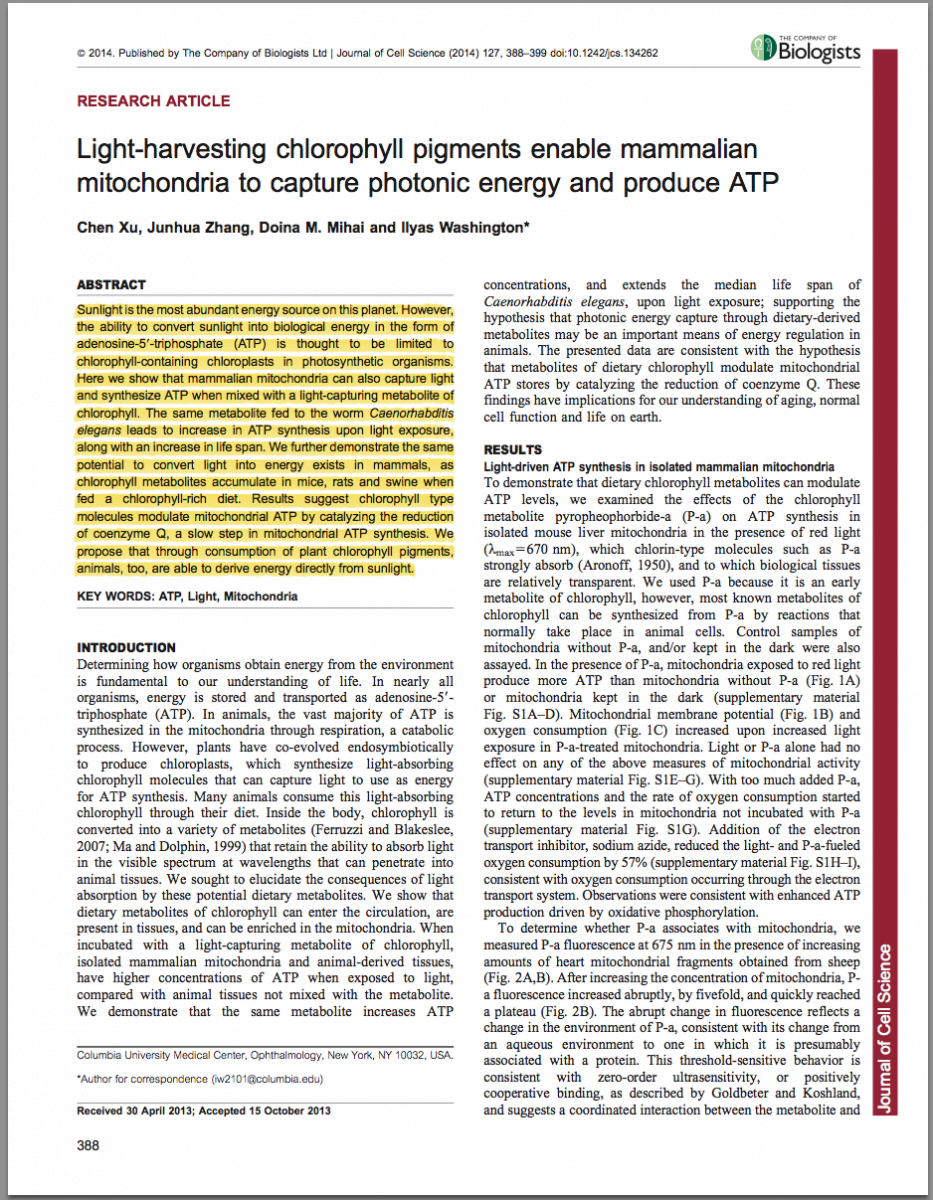
Animals are Not Just Glucose-Burning Biomachines, But Are Light-Harvesting Hybrids
For at least half a century it has been widely believed among the scientific community that humans are simply glucose-dependent biomachines that can not utilize the virtually limitless source of energy available through sunlight to supplement our energy needs. And yet, wouldn’t it make sense that within the extremely intelligent and infinitely complex design of life, a way to utilize such an obviously abundant energy source as sunlight would have been evolved, even if only for the clear survival advantage it confers and not some ethical imperative (which is a possibility worth considering … vegans/Jainists, are you listening?).
As the philosopher of science Karl Popper stated, a theory can only be called scientific if it is falsifiable. And indeed, the scientific theory that humans are solely heterotrophic has just been overturned in light of empirical evidence demonstrating that mammals can extract energy directly from sunlight.
Deeper Implications of the New Study
First, let’s start by reading the study abstract, as it succinctly summarizes what may be of the most amazing discoveries of our time:
Sunlight is the most abundant energy source on this planet. However, the ability to convert sunlight into biological energy in the form of adenosine-59-triphosphate (ATP) is thought to be limited to chlorophyll-containing chloroplasts in photosynthetic organisms. Here we show that mammalian mitochondria can also capture light and synthesize ATP when mixed with a light-capturing metabolite of chlorophyll. The same metabolite fed to the worm Caenorhabditis elegans [roundworm] leads to increase in ATP synthesis upon light exposure, along with an increase in life span. We further demonstrate the same potential to convert light into energy exists in mammals, as chlorophyll metabolites accumulate in mice, rats and swine when fed a chlorophyll-rich diet. Results suggest chlorophyll type molecules modulate mitochondrial ATP by catalyzing the reduction of coenzyme Q, a slow step in mitochondrial ATP synthesis. We propose that through consumption of plant chlorophyll pigments, animals, too, are able to derive energy directly from sunlight.”
And so, to review, the new study found that animal life (including us, mammals) are capable of borrowing the light-harvesting capabilities of ‘plant blood,’ i.e. chlorophyll and its metabolites, and utilize it to photo-energize mitochondrial ATP production. This not only helps to improve energy output, but the research found several other important things:
- Despite the increased output, the expected increase in Reactive Oxygen Species (ROS) that normally attends increased mitochondrial function was not observed; in fact, a slight decrease was observed. This is a highly significant finding, because simply increasing mitochondrial activity and ATP output, while good from the perspective of energy, may accelerate aging and other oxidative stress (ROS) related adverse cellular and physiological effects. Chlorophyll, therefore, appeared to make animal mitochondria function in a healthier way.
- In support of the above finding, worms administered an optimal range of chlorophyll were found to have significant extended life span. This is in accordance with well-known mechanisms linked to improved mitochondria function (in the absence of increased ROS) that increases cell longevity.
The last point in the abstract above is especially interesting to me. As a fan of coenzyme q10 supplementation for sometime, I have noticed profound differences qualitatively between ubiquinone (the oxidized form) and ubiquinol (the reduced, electron rich form), the latter of which has lead me to experience far greater states of energy and well-being than the former, even at far lower quantities (the molecular weight of a USP isolate does not reveal its bioavailability nor biological activity). The study, however, indicates that one may not need to take supplemental coenzyme Q10, even in its reduced form as ubiquinol, because chlorophyll-mediated sunlight capture and subsequent photo-energization of the electron transport chain will naturally ‘reduce’ (i.e. donate electrons) ubiquinone converting it into ubiquinol, which will result in increased ATP production and efficiency. This may also explain how they observed no increase in ROS (reactive oxygen species) while increasing ATP production: coenzyme q10 in reduced form as ubiquinol is a potent antioxidant, capable of donating an electron to quench/neutralize free radicals. This would be a biological win-win: increased oxidative phosphyloration-mediated energy output without increased oxidative damage.

Finally, in order to grasp the full significance of the study, one must read the authors’ conclusion:
Both increased sun exposure (Dhar and Lambert, 2013; John et al., 2004; Kent et al., 2013a; Kent et al., 2013b; Levandovski et al., 2013) and the consumption of green vegetables (Block et al., 1992; Ferruzzi and Blakeslee, 2007; van’t Veer et al., 2000) are correlated with better overall health outcomes in a variety of diseases of aging. These benefits are commonly attributed to an increase in vitamin D from sunlight exposure and consumption of antioxidants from green vegetables. Our work suggests these explanations might be incomplete. Sunlight is the most abundant energy source on this planet. Throughout mammalian evolution, the internal organs of most animals, including humans, have been bathed in photonic energy from the sun. Do animals have metabolic pathways that enable them to take greater advantage of this abundant energy source? The demonstration that: (1) light-sensitive chlorophyll-type molecules are sequestered into animal tissues; (2) in the presence of the chlorophyll metabolite P-a, there is an increase in ATP in isolated animal mitochondria, tissue homogenates and in C. elegans, upon exposure to light of wavelengths absorbed by P-a; and (3) in the presence of P-a, light alters fundamental biology resulting in up to a 17% extension of life span in C. elegans suggests that, similarly to plants and photosynthetic organisms, animals also possess metabolic pathways to derive energy directly from sunlight. Additional studies should confirm these conclusions.
I think it is obvious that there are a wide range of implications this discovery holds for the fields of nutrition, medicine, and cell and evolutionary biology, to name but a few disciplines that will inevitably be profoundly affected, if not entirely transformed.
For example, as far as implications to the hotly debated field of ascertaining the ideal, ancestrally-based human diet, if animal cells evolved to be able to harness the energy of sunlight through the help of the ‘blood’ of our plant allies, then isn’t it reasonable to believe that in order to optimize our biological potential nutritionally we require a certain amount of chlorophyll to take advantage of sunlight for our energy needs and perhaps evade sole reliance on the glucose-dependent energy pathways of the body whose overexpression and carbohydrate-rich dietary correlate are linked to conditions like cancer, obesity and cardiovascular disease? When one considers the potential of sunlight (a regular, daily, guaranteed source of energy) to contribute to our daily metabolic energy needs (and therefore the survival advantage conferred by regular consumption of chlorophyll-rich plant material), shouldn’t the Paleo community, which is highly fixated on animal tissue consumption, now be compelled towards putting chlorophyll on a higher level of importance versus conventional ‘Paleo’/heterotrophic sources of sustenance, e.g. forged/hunted food?
Also, what are the implications for the increasing ambivalence within public awareness concerning sunlight exposure, where on the one hand it is viewed as a vital, if not life-saving source of vitamin D, while on the other hand a vector of lethality in skin cancer causation, against which especially pigment deficient races slather on various petrochemical preparations to defend themselves against? What if sunlight (as was evidenced in the roundworm model) is toxic when no chlorophyll is present in our diet and tissues, but promotes both increased ATP and longevity when found there in optimal doses? These are just a few of the questions that are now on the table, following these recent discoveries.
Of course, there are many other implications of the study, and likely far more questions than answers now that should be investigated further. I hope you the reader will help provide additional insight and share it below or in follow up articles that you are welcome to submit for publication by emailing us here.
How to Put The Research Into Practical Application?
How do we translate this study into real life application? This has been a common question for those loyal followers of Greenmedinfo.com: “I love the research, but what do I do with it?”

First, green vegetables and their juices should no longer viewed simply as sources of antioxidants, alphabetic vitamins, nutrients, minerals etc., but carriers of essential mitochondrial cofactors without which our body can not optimally and efficiently produce ATP, and without which our body can not realize its biological potential for maximal longevity. Of course, if you have been long time followers , you know we also look at ancestral foods (i.e. those which have been in the human diet for over 10,000 years) as highly dense and vitally important sources of biologically useful information which have become indispensable regulators of gene expression. This means that when you are consuming a glass of green vegetable juice, for instance, it is likely the most precious health promoting elixir on the planet and should be considered something of a nutritional ‘bridge’ we, heterotrophs, can cross to become photoheterophic or light-capturing organisms, if we choose to be. (Interested further in the human relationship to light? Read: Biophotons: The Human Body Emits, Communicates with, and is Made from Light).
Here is my suggestion. On top of increasing the consumption of green foods and/or vegetable juices, add in a liquid or encapsulated supplement that provides at least 200mg of additional chlorophyll daily. In combination, make sure to get additional sunlight and engage in energy intensive, outdoor activities simultaneously. If you like, visualize sunlight entering into the tissues of your body reaching deep down into your chlorophyll-metabolite saturated mitochondria. Then observe and assess how you feel energetically following this exercise. Do you feel more energy? Less exhausted afterwards? Please report back your experiences in the comments below so we can compare notes and continue to explore how to apply this finding to our daily lives in a useful way.
This study, along with several others more recent papers, represent a Copernican-type revolution in cellular bioenergetics. What if chlorophyll, water, and our body’s own melanin produced were capable of producing most of our body’s energy needs? Stay tuned for further reporting on this topic, including guest posts by noted scientists and clinicians who are also aware of the importance of this research and wish to help flesh out the theoretical implications and real world applications to human health.
References
[1] Moran, N. A. & Jarvik, T. Lateral transfer of genes from fungi underlies carotenoid production in aphids. Science (New York, NY) 328, 624–627 (2010).
Disclaimer: We at Prepare for Change (PFC) bring you information that is not offered by the mainstream news, and therefore may seem controversial. The opinions, views, statements, and/or information we present are not necessarily promoted, endorsed, espoused, or agreed to by Prepare for Change, its leadership Council, members, those who work with PFC, or those who read its content. However, they are hopefully provocative. Please use discernment! Use logical thinking, your own intuition and your own connection with Source, Spirit and Natural Laws to help you determine what is true and what is not. By sharing information and seeding dialogue, it is our goal to raise consciousness and awareness of higher truths to free us from enslavement of the matrix in this material realm.
Português
 EN
EN FR
FR



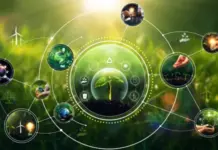



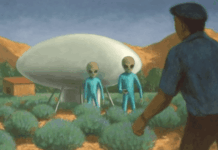



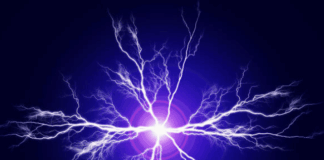
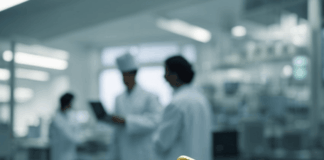













thank you so much,great article indeed. since we add juice from wild plant too,radical change in health is feelable….
Thank you for the lovely take of something great to feel good anytime.
Very intriguing. Speaking of revolutionary healing methods ~ would there be any room to feature channeled healing music on the blog at all? The unique form I bring through the piano basically DEEPLY ANCHORS the often-missing Feminine stability into anything (healing sessions, meditations, interviews, what have you!), allowing the unfolding of the event to be more aligned with the sacred goddess geometry of Pure love (which prevents and heals all metamorphosizing/cancerous energy-forms :P).
Check it out sometime, and don’t hesitate to e-mail this account (I’ll try to find a place to write you!) ~ http://patreon.com/4improv and http://musicalhealing.bandcamp.com
Bless,
-Eugene
And don’t forget Essential oils!
The plants will give it up to us every single time. No need to look any further (for me).
Hip-Hip Hurray for plants!
what a wonderful revelation. amazing ground breaking information. this should be viral as all of humanity desperately needs this benefit free energy for the body from the sun and a 17% longer healthy life wow. sign me up… thank you justin turner, Springfield Oregon…
I take spirulina tabs but young barley green sprouts can be found powdered.
Awesome share Colaborama, thank you friend for the sharing.
🙂
We ARE nature. We require things a plant requires. A plant based diet is the only one for me!